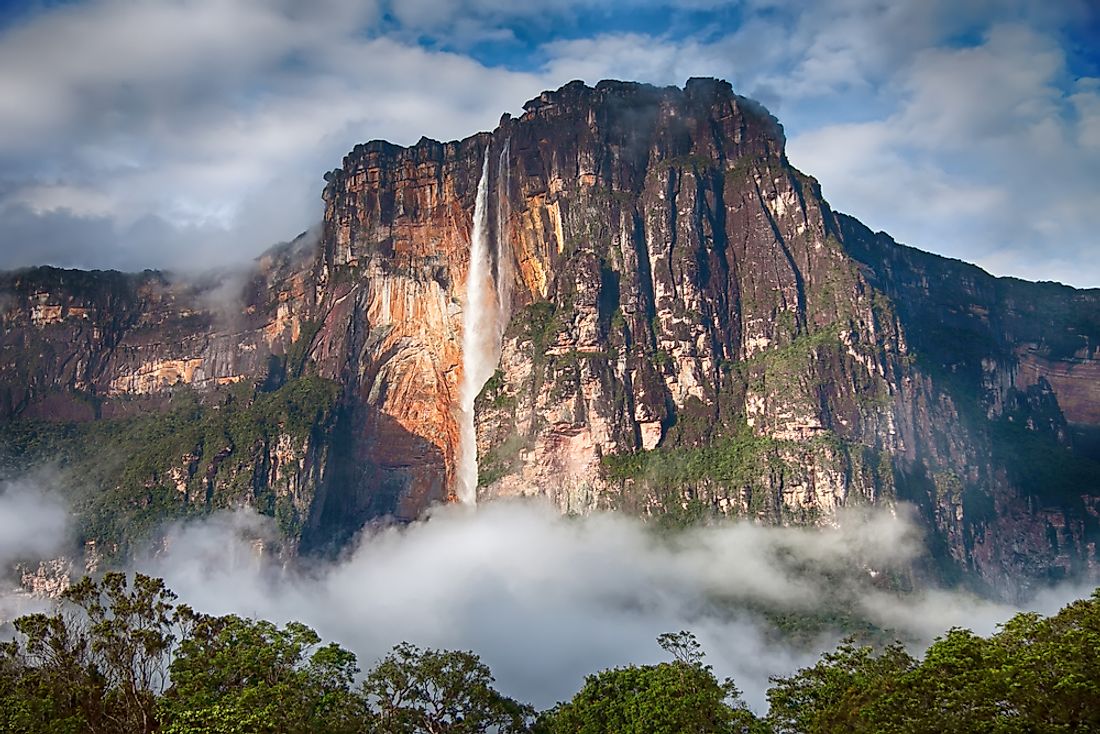Angel Falls, Venezuela - Unique Places around the World

5. Description
Dropping from a height of 979 meters from the recesses of Mount Auyantepui in the Canaiman National Park, Bolivar, Venezuela, the Angel Falls is one of the most unique natural wonders of the world. It is the highest waterfall in the world, and is almost 19 times higher than the famous Niagara Falls. The story behind the name of this spectacular cascade is quite an interesting one. In 1933, James Crawford Angel, an American aviator, first discovered the falls as he flew over it while on a journey in search of gold. The falls attracted further attention after an incident in 1937, when Angel again flew over the region with his wife and two other companions, and his aeroplane became stuck atop the Ayuantepui Mountain over the falls. This forced all four of them to trek down through the Canaiman wilderness for 11 days, until they finally reached civilization. News of this incident spread like wildfire, and from then on explorers from all over the globe started taking interest in the waterfall and its surrounding wilderness. James Angel was thus credited with his discovery of the falls, and they were named in his honor as the 'Angel Falls'.
4. Tourism
Even though the Angel Falls does not receive a high tourist footfall due to its remote location, the ones who dare to venture into the region are highly regarded as extraordinary globetrotters. The jaw-dropping cascade is located 160 miles southeast of the Ciudad Bolivar city of Venezuela, while the Venezuelan capital of Caracas is located significantly further (about 1000 miles) from the site. Angel Falls can be viewed either from an aircraft flying atop the falls, or reached by a boat via the Churun River. Whatever be the chosen mode of conveyance to get there, the journey to the falls promises a lot of adventure. The best season to visit the Angel Falls is the wet season, when the volume of the flowing water is at its peak, and the Churun River is high enough to easily navigate the boat to reach the falls. Unless one is an extreme adventurist who is ready to hike for days through the dense and dangerous forestland to reach the falls, visitors will need to book a package with one of the professional tour operators operating in the region.
3. Uniqueness
Angel Falls is unique, because of both its sheer height and also its remote location in the heart of the Canaiman wilderness. This destination has all the attributes required to be designated as a UNESCO World Heritage Site, and is popular among those adventurers and explorers of the world who love to see nature in its most unspoiled form. The most striking geological feature of the Canaiman region is its characteristic table-top mountains, or tepuis. These were formed millions of years ago, with vertical walls and flat tops. The Angel Falls, which itself is nestled in the recesses of Mount Ayuantepui, is thus surrounded by an arresting landscape comprised by the tepuis, waterfalls, and lush, green, forested lands. The region is highly rich in biodiversity, with a wide variety of flora and fauna thriving throughout this unique ecosystem. The Angel Falls region is also home to the native Pemon community, who depend on agriculture, hunting and fishing for their sustenance. The Pemon people revere the tepuis as the protectors of their homeland and, according to the Pemon tradition, attempts to climb these mountains are strictly prohibited.
2. Habitat
The Canaima National Park, with its vast and verdurous open savannahs and spectacular table mountains (tepuis), spans across a large area (about 3 million hectares) in southeastern Venezuela, bordering the countries of Brazil and Guyana. This area, which hosts the Angel Falls, thrives with flora and fauna as diverse as it is unique. Around 500 species of orchids have been recorded in the park. The fauna of the region includes an incredible variety of mammals, such as the giant anteater, jaguar, Brazilian tapir, giant armadillo, pale-throated three-toed sloth, and capybara. A large number of primate species live there as well, such as the howler monkeys, titi monkeys, the white-faced saki, and others. A great number of avian species have also been recorded in this region, and include the jabiru, harpy eagle, black-faced hawk, painted parakeet, red-shouldered macaw, great tinamou, and others. About 60 amphibian and 70 reptilian species also thrive in the Canaima National Park. Snakes with a dangerous reputation therein include the coral snake, the fer-de-lance, the boa constrictor, and the bushmaster.
1. Threats
Even though a trip to the Angel Falls could mean an experience of a lifetime, certain dangers can follow tourists if proper precautions are not adopted for use. Crime is a huge concern in Venezuela, and reports of tourists being mugged by criminals are not uncommon. Vector, water-borne, and air-borne pathogens are quite common in the forests of the Canaima National Park, rendering tourists susceptible to a wide variety of life-threatening diseases caused by these pathogens. Venomous snakes and toads, and a number of other toxic plants and animals, also thrive in the dense forests surrounding the Angel Falls. An unfortunate encounter with any such species could mean serious trouble for the visitors to this wild land. The foliage and the fast flowing rivers in the Canaima National Park are often unexplored and considered untamed. Hence, it is wise practice for tourists to respect the rules of the land, and listen to the warnings of the locals before they venture out on an adventurous journey to the Angel Falls. Even though the Canaima National Park is quite well protected by conservation measures, human-related interventions, such as unregulated tourism, the clearing of nearby forests to accommodate the growing human population, wildfires, and a lack of sufficient trained personnel and infrastructure to maintain the area's integrity continue to threaten the biodiversity of the park.







